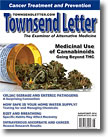|
Doctored Results: The Suppression of Laetrile at
Sloan-Kettering Institute for Cancer Research
by Ralph Moss, PhD
Equinox Press Inc.; PO Box 1076, Lemont, Pennsylvania 16851
© 2014, softcover, $19.95, 241 pp. |
|
|
Those of us who were around during the 1970s may recall the controversy over the cancer treatment laetrile. It entered the public debate not long after Richard Nixon declared the War on Cancer in 1971. The three-person panel directing this new effort had two members who were Sloan-Kettering leaders, putting Sloan-Kettering in a most influential position in cancer research.
One of the first tasks of the panel was to respond to the public demand for clinical testing of laetrile. Amygdalin, or laetrile as it is popularly known, is a product made from the pits of apricots. It has been under debate since 1953 as to whether or not it is effective in treating cancer. Some considered it beneficial and others regarded it as quackery. It fell to Sloan-Kettering to research laetrile.
In 1974, Memorial Sloan-Kettering Cancer Center hired Ralph Moss to be a science writer in its Department of Public Affairs. Moss, a man with a background in the classics and awareness of the political issues of the day, found himself with an insider's view of research and testing of the controversial laetrile through his ability to interview administrators and researchers. This book, Doctored Results, is an historical account of Sloan-Kettering's research into laetrile.
One of Moss's first interviews was with a respected researcher named Kanematsu Sugiura, DSc, who in 1972 was asked to test laetrile in spontaneously occurring tumors in mice. Until this point, Sugiura's career was remarkable for his dedication to his chemotherapy research that brought him accolades for his 60-year career and over 250 papers and articles. He took a hands-on approach to his research, which often meant that he was at his lab daily to tend to the lab animals – even as he was approaching his 80s.
Sugiura's first experiments with laetrile showed very positive results, especially with regard to stopping metastases. He was asked to repeat his experiments, and when a higher dose was used, the results were even better. Again he was asked to repeat using a different method of evaluating metastases, then again with a different source of laetrile, until his tests numbered nine. All had positive outcomes. His results showed that laetrile temporarily stopped the growth of small tumors, reduced the size of cancerous organs, stopped the spread of cancer, and improved the animal's appearance and well-being. Sugiura concluded that laetrile was not a cure for cancer but a "good palliative drug."
What followed Sugiura's experiments is really the crux of this book. Laetrile had entered the public dialogue as a quack remedy, so much of the response from the cancer institutions, lay press, science press, and individual researchers had to do with whether Sloan-Kettering was going to endorse a quack treatment. In the minds of some, including other researchers at Sloan-Kettering, Sugiura's research must not stand.
One example of how Sugiura's research was smeared had to do with the same techniques that he had always used without controversy and are still used today. First, he made a visual inspection of the lungs excised from the mice, using the naked eye and a magnifying lens. This is called a macroscopic examination. An independent pathologist would then verify using slides of the same lungs, but under a microscope. There was a high degree of agreement between them. Nonetheless, Sloan-Kettering found this method too subjective but not that of researchers Elisabeth Stockert, DPhil, and Franz Schmid, DVM, who used only the naked eye examination. As a result they concluded that they could not duplicate Sugiura's results.
In a more interesting challenge, Daniel Martin, MD, a fervent quack-buster, used his novel method that he called bioassay. This method did not rely on visual examination at all but rather called for mincing the lungs from each mouse, dividing that material into portions, and injecting it into two male mice. The test was positive if a tumor, detected by palpation, developed at the injection site. Using this method, Martin could not duplicate Sugiura's research. Even though the bioassay was invented by Martin and had never been verified by any other source, Sloan-Kettering lauded this method as less subjective than macrovisual or microscopic examination. Eventually, it turned out that the results of the bioassay method were not really valid because what could be identified as a tumor was found sometimes to be an inflammatory response to the injection. The bioassay's utility apparently was only for refuting Sugiura's work and it was not used again.
The administrators and officers of Sloan-Kettering kept up their campaign against Sugiura, his research, and laetrile itself at various hearings, meetings, and press conferences. At these events, Moss was able to track the changing behavior of the very scientists and administrators whom he had interviewed and come to know. The message became less nuanced and more absolute – laetrile has no value in the struggle to cure cancer and does not deserve further research.
Moss presents this story as a chronological narrative. He does not sensationalize the topic but rather provides a detailed historical record. Other than the fact that laetrile was considered a quack remedy, he does not say much about the reasons that it was so despised. For that discussion, he directs readers to his book The Cancer Industry.
We are no longer surprised when institutions fail to live up to their supposed ideals, but institutions are composed of individuals who are making value judgments on the job every day. In this story we see the esteemed, rewarded, and awarded individuals cave in to external pressures and their own personal agendas – except for one. For that, Kanematsu Sugiura deserves his place in the historical record, as does Ralph Moss for preserving this story.


|
|
![]()
![]()
![]()




